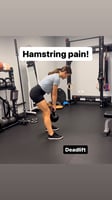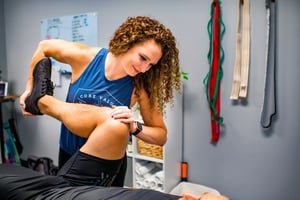Have you ever tried to open your mouth and it got stuck? Do you have a sore and painful jaw? How about neck pain and facial pain?
It sounds like you could be suffering from TMD, which is short for temporomandibular dysfunction, aka jaw problems.
Here is a little bit of an anatomy lesson on the jaw: The jaw is made up of two bones, the temporal bone and the mandible. The joint is tiny but does have a disc that rolls and glides with mouth opening and closing.
The primary muscles of chewing/closing, also known as mastication, include the masseter, temporalis and the medial and lateral pterygoid. Any of these muscles can contribute to jaw and neck pain and will be evaluated and treated as needed.
The jaw is innervated by branches of the Trigeminocervical and there is wiring overlap with the C1-C3 spinal nerves which innervate the neck.

Okay, now for the dysfunction part.
TMD commonly presents as pain in the jaw but can also include clicking, catching, lock jaw on either opening or closing and/or tension in the muscles. The jaw however, is very closely connected to the neck and you can’t really look at one without considering the other.
Posture is important in this clinical population because a forward head puts a posterior and inferior force on the mandible and requires the muscles that close the jaw to remain in a tensed position when they should be relaxed. It would be like walking around all day holding a bowl of soup in your hand; over time that bicep and elbow are going to get very cranky with you.The forward head can also lead to an anterior displacement of the tiny little disc that sits in the TMJ joint which will change the way the joint functions.
Just like any joint, the TMJ can have dysfunction within, called intra-articular, or outside of the joint, called extra-articular, or both!
Extra-articular examples can include:
-
Muscle guarding, overuse, increased resting tension
-
Bad habits such as teeth clenching, grinding, nail biting, gum chewing
-
Trauma: such as dental work
-
Referred pain to the head, neck and face
-
Tenderness and trigger points in the muscles at the jaw
Intra-articular examples:
-
Trauma: direct hit to the face
-
Joint clicking or popping
-
Grinding, grating or crepitus
-
Movement deviations, jaw tracking problems
-
Catching or locking either open or closed
What will your PT look for?
-
Pain presentations/pattern: time of day, stress levels, eating related pain
-
Joint deviations: C or S curves
-
Joint mobility: stiffness or painful joint movement
-
Range of motion: looking for full range availability as well as symptoms with range of motion, including pain, clicking, deviation
-
Palpation of the joints and muscles of the neck and jaw: SCM, suboccipitals, UT, Temporalis, masseter, pterygoid, joint line
-
Posture and breathing patterns
Treatment:
-
TMJ manipulation/mobilization
-
Cervical Manipulation/mobilization
-
Dry-needling
-
Soft tissue mobilization
-
Strength training
-
Breathwork for diaphragm function
People with chronic neck pain have lower force/strength availability meaning that improving their neck strength is so important!
To address your TMJ, first we’d calm it down, then we’d figure out the root cause of the problem to give you long term relief, then build you back up so your jaw is resilient for life!



